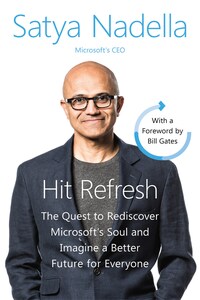William Collins
An imprint of HarperCollinsPublishers
1 London Bridge Street
London SE1 9GF
www.WilliamCollinsBooks.com
This eBook first published in Great Britain by William Collins in 2017
Copyright © 2017 Satya Nadella
Foreword © 2017 William H. Gates III
Cover design by Milan Bozic
Cover photograph © Microsoft
Satya Nadella asserts the moral right to be identified as the author of this work
A catalogue record for this book is available from the British Library
All rights reserved under International and Pan-American Copyright Conventions. By payment of the required fees, you have been granted the non-exclusive, non-transferable right to access and read the text of this e-book on-screen. No part of this text may be reproduced, transmitted, down-loaded, decompiled, reverse engineered, or stored in or introduced into any information storage and retrieval system, in any form or by any means, whether electronic or mechanical, now known or hereinafter invented, without the express written permission of HarperCollins
Source ISBN: 9780008247652
Ebook Edition © September 2017 ISBN: 9780008247676
Version: 2018-06-27
I’ve known Satya Nadella for more than twenty years. I got to know him in the mid-nineties, when I was CEO of Microsoft and he was working on our server software, which was just taking off at the time. We took a long-term approach to building the business, which had two benefits: It gave the company another growth engine, and it fostered many of the new leaders who run Microsoft today, including Satya.
Later I worked really intensely with him when he moved over to run our efforts to build a world-class search engine. We had fallen behind Google, and our original search team had moved on. Satya was part of the group that came in to turn things around. He was humble, forward-looking, and pragmatic. He raised smart questions about our strategy. And he worked well with the hard-core engineers.
So it was no surprise to me that once Satya became Microsoft’s CEO, he immediately put his mark on the company. As the title of this book implies, he didn’t completely break with the past—when you hit refresh on your browser, some of what’s on the page stays the same. But under Satya’s leadership, Microsoft has been able to transition away from a purely Windows-centric approach. He led the adoption of a bold new mission for the company. He is part of a constant conversation, reaching out to customers, top researchers, and executives. And, most crucially, he is making big bets on a few key technologies, like artificial intelligence and cloud computing, where Microsoft will differentiate itself.
It is a smart approach not just for Microsoft, but for any company that wants to succeed in the digital age. The computing industry has never been more complex. Today lots of big companies besides Microsoft are doing innovative work—Google, Apple, Facebook, Amazon, and others. There are cutting-edge users all around the world, not just in the United States. The PC is no longer the only computing device, or even the main one, that most users interact with.
Despite all this rapid change in the computing industry, we are still at the beginning of the digital revolution. Take artificial intelligence (AI) as an example. Think of all the time we spend manually organizing and performing mundane activities, from scheduling meetings to paying the bills. In the future, an AI agent will know that you are at work and have ten minutes free, and then help you accomplish something that is high on your to-do list. AI is on the verge of making our lives more productive and creative.
Innovation will improve many other areas of life too. It’s the biggest piece of my work with the Gates Foundation, which is focused on reducing the world’s worst inequities. Digital tracking tools and genetic sequencing are helping us get achingly close to eradicating polio, which would be just the second human disease ever wiped out. In Kenya, Tanzania, and other countries, digital money is letting low-income users save, borrow, and transfer funds like never before. In classrooms across the United States, personalized-learning software allows students to move at their own pace and zero in on the skills they most need to improve.








